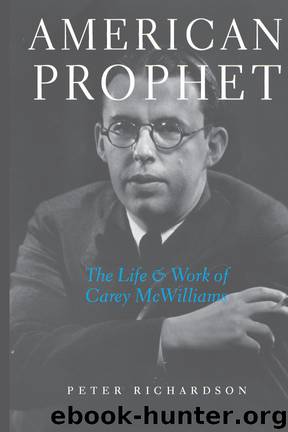American Prophet by Richardson Peter

Author:Richardson, Peter
Language: eng
Format: epub
Publisher: University of Michigan Press
But in California the lights went on all at once, in a blaze, and they have never been dimmed. It was, of course, the discovery of gold that got California off to a flying start, and set in motion its chain-reaction, explosive, self-generating pattern of development. (25)
Gold mining was also important for the template it created for the state's future growth.
In manifold ways California has been reenacting the drama of the gold rush—at different levels, in different forms, but always in striking conformity with the underlying pattern set in the crucial first two decades.(64)
Over fifty years later, anyone who witnessed the growth of the high-technology sector in and around Silicon Valley might concur with McWilliams's observation.
Gold mining had other consequences for California as well. It began a pattern of uninterrupted population growth based largely on domestic and international in-migration, which helped account for the exceptional diversity of the state's population: “In California, for the first time, Americans of every type, profession, background, and social class were thrown together in the great and compulsive confraternity of gold miners” (65). Furthermore, the gold rush shaped the state's attitudes about labor, women, and agriculture. Beginning with the discovery of gold, labor was more respectable in California than in many other places. The new state attracted high-skill workers, its geographic isolation strengthened their position, and anti-Asian agitation was used freely to build a more powerful labor movement. (The exception was farm labor, to which McWilliams devotes a separate chapter.) Because California's gold rush created a frontier society, women were scarce; as McWilliams notes, “Where women are at a premium, women's rights are freely granted” (80). Finally, mining had implications even for California's agricultural economy. In its large-scale, exploitative, corporate approach, “farming has always resembled mining in this state. The soil is really mined, not farmed” (101). Whatever its historio-graphical merits, McWilliams's exceptionalist thesis was a useful organizing device. By stressing the state's anomalousness and tracing it to a single source, McWilliams could simultaneously cover his favorite topics and tame a mass of disparate material.
Turning his attention to the state's political institutions, which he also regards as unique, McWilliams notes the absence of party machines and bosses, the state's tradition of independent voting, and the unusual power wielded by lobbyists and campaign consultants. The first two features are obviously related. In a state characterized by massive in-migration and high mobility, party machines are not especially adaptive: “Political machines simply cannot function with efficiency in areas which are largely made up of newcomers and strangers” (194). Furthermore, California's system of cross-filing weakened party regularity and discipline, and the state's voters were notably independent. The title of the chapter on this subject—”The State that Swings and Sways”—provides a serviceable description not only of California in 1949, when nonpartisan Earl Warren was on his way to a third term as governor, but also of the state today. Although a lack of party loyalty is even now reported as an emergent political trend, McWilliams quotes a study of voting
Download
This site does not store any files on its server. We only index and link to content provided by other sites. Please contact the content providers to delete copyright contents if any and email us, we'll remove relevant links or contents immediately.
| Africa | Asia |
| Canadian | Europe |
| Holocaust | Latin America |
| Middle East | United States |
Fanny Burney by Claire Harman(26260)
Empire of the Sikhs by Patwant Singh(22778)
Out of India by Michael Foss(16695)
Leonardo da Vinci by Walter Isaacson(12821)
Small Great Things by Jodi Picoult(6697)
The Six Wives Of Henry VIII (WOMEN IN HISTORY) by Fraser Antonia(5246)
The Wind in My Hair by Masih Alinejad(4853)
The Crown by Robert Lacey(4580)
The Lonely City by Olivia Laing(4579)
A Higher Loyalty: Truth, Lies, and Leadership by James Comey(4568)
The Iron Duke by The Iron Duke(4130)
Millionaire: The Philanderer, Gambler, and Duelist Who Invented Modern Finance by Janet Gleeson(4119)
Papillon (English) by Henri Charrière(3925)
Sticky Fingers by Joe Hagan(3918)
Joan of Arc by Mary Gordon(3801)
Alive: The Story of the Andes Survivors by Piers Paul Read(3743)
Stalin by Stephen Kotkin(3732)
Aleister Crowley: The Biography by Tobias Churton(3435)
Ants Among Elephants by Sujatha Gidla(3282)
